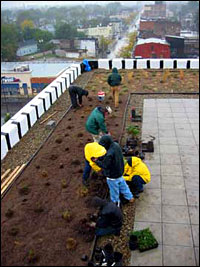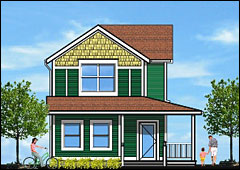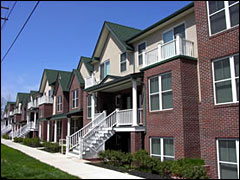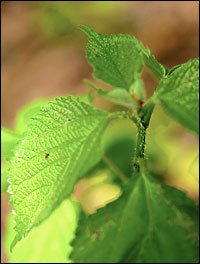 Still known for smokestacks and football, Cleveland is turning its ship around.Photo: Craig Hatfield“Most people know Cleveland by the Browns or The Flats,” says Marc Lefkowitz. From the roof of his office building, which is dotted with native wildflowers and grasses, he gestures to the downtown skyline — marked by the iconic Mittal Steel smokestacks that gave The Flats neighborhood its name — and toward the beloved football team’s stadium along the shimmering shores of Lake Erie.
Still known for smokestacks and football, Cleveland is turning its ship around.Photo: Craig Hatfield“Most people know Cleveland by the Browns or The Flats,” says Marc Lefkowitz. From the roof of his office building, which is dotted with native wildflowers and grasses, he gestures to the downtown skyline — marked by the iconic Mittal Steel smokestacks that gave The Flats neighborhood its name — and toward the beloved football team’s stadium along the shimmering shores of Lake Erie.
That two-pronged version of the city’s reputation may be wishful thinking on the part of Lefkowitz, web editor for a local green nonprofit called Green City Blue Lake. Because most people — if they give Cleveland much thought at all — probably see it as a Rust Belt city, a victim of white flight and the decaying industrial economy, and of environmental gaffes in the 1970s when Lake Erie was declared dead and the nearby Cuyahoga River was so choked with pollution that it caught fire.
The good news is, those ecological and economic atrocities planted the seeds of an early social justice, anti-poverty, and environmental movement in the city that has of late begun to blossom into a full-fledged sustainability movement. Cleveland is one of a handful of cities in the Rust Belt — including Pittsburgh, Milwaukee, Detroit, and Columbus — that are reinventing the region as a sort of Green Belt.
The movement here is largely rooted in nonprofit groups and citizen activists like Lefkowitz and GCBL, but the city government is doing its part. Cleveland was the second U.S. city to sign the U.N. Global Compact, a charter for businesses to align themselves with human rights, labor, environmental, and anti-corruption practices; it also hired a sustainability programs manager in 2005, slightly ahead of the sustainability curve. Last year, the American Public Transportation Association named Greater Cleveland’s Regional Transit Authority the best transit system in America.
But the real test of success will be if a green economy sprouts. The smokestacks in The Flats — whose factories and steel mills have given way to luxury lofts perched above posh pubs filled with martini-sipping patrons — may never spew steam again. That’s a good thing, of course, for air pollution purposes, but eco-activists here hope a form of green industry will take root instead. If the flowers popping on GCBL’s roof are any indication, green Cleveland may soon come into bloom.
The Wild (Mid-)West
Green City Blue Lake (formerly EcoCity Cleveland) can take credit for jumpstarting many a sustainability initiative here. Even its name embodies the vision: a city no longer muddied with brownfields, but reborn green, on a lake that’s no longer swirling in pollution, but a clear and healthy blue.

The GCBL green roof comes into being.
Photo: ecocitycleveland.org
Started in 1992 by David Beach, currently the organization’s executive director, GCBL’s undertakings include the BLUE (Building the Livable Urban Edge) Project, which aims to improve waterfront access and quality; an urban “EcoVillage” of affordable green homes; and a climate change plan for the region. Last July, the group merged with the Cleveland Museum of Natural History, which will now be home to the Green City Blue Lake Institute and their joint Center for Regional Sustainability.
The group’s current headquarters — until they move to the museum this summer — sits in the heart of the Ohio City neighborhood, characterized by the low-rent but gentrifying commercial activity along Lorain Avenue: used-car lots, ethnic grocers, and corner bars mixed with antique shops. Its 1920s-era, four-story building is the city’s very first green-retrofit construction project, renovated in 2003 with features like a geothermal unit, solar panels, a partial green roof, and stormwater retention. The building is also home to some of the most active and influential green groups in the city, including The Nature Conservancy, the Cleveland Green Building Coalition, and Environmental Health Watch, a public health group that works to prevent and reduce exposure to harmful substances.
The building exemplifies a larger strategy for revitalizing Cleveland: luring folks back with the promise of reasonably priced real estate. “The intention of this space was to offer nonprofit groups below-market rent, to entice them to come here,” says Lefkowitz. GCBL hoped its example — siting a green business in a vibrant neighborhood — would encourage other like-minded businesses to follow its lead.
And indeed they are — at least a little bit. Great Lakes Brewing Company is just down the street. The brewer powers its delivery truck (and a shuttle bus called “The Fatty Wagon” that transports fans to and from Cleveland Indians games) with restaurant vegetable oil, educating customers on the benefits of veggie oil power, which produces 40 percent less soot than diesel and 25 percent less pollution. Farther east, closer to downtown, lies the country’s only American League stadium with a solar panel roof.
The Incredible Shrinking City
Despite some bustling neighborhoods, Cleveland still suffers from a shrinking population. The local paper reported that Cuyahoga County had the sixth-largest population decline in the U.S. between July 2005 and July 2006; only Detroit and cities addled by Hurricane Katrina lost more residents.
These days, the city needs to entice newcomers to join its 500,000 citizens and to fill the ever-increasing number of vacant homes in town; according to The New York Times, Cleveland also has one of the highest foreclosure rates in the country.
“We’ve been heavily hit by the mortgage-lending crisis, and we’re taking down about a thousand homes per year,” says Andrew Watterson, program director of the city’s office of sustainability. One solution: houses both green and affordable in the form of the Cleveland EcoVillage, a pedestrian-friendly neighborhood linked to mass transit.
The project is the brainchild of five local nonprofits (Detroit Shoreway Community Development Organization, Environmental Health Watch, Cleveland Green Building Coalition, EcoCity Cleveland, and Cuyahoga Community Land Trust, an organization that promotes the land-trust model of home ownership), the city, the regional transit authority, private developers, and neighborhood residents. They aim to bring residents back to the Detroit Shoreway neighborhood, and to serve as an example to other cities of how to redevelop the inner city in a green fashion.

An affordable, efficient Green Cottage.
Image: gcbl.org
Near the newly renovated West 65th Street rapid transit station, Cuyahoga Community Land Trust is in the process of building five two- and three-bedroom homes, between 1,226 and 1,350 square feet each, called the Green Cottages. They’re designed to be LEED-certified and models of energy efficiency, with projected heating costs of just $36 a month thanks to energy-saving appliances and heavy insulation. The houses — which will be sold for between $105,000 and $125,000 to homeowners earning no more than 80 percent of Cuyahoga County’s median income ($34,800 for a single person; for a family of four, $49,700) — will break ground this summer.
“It’s important to keep a range of diverse incomes to keep the neighborhood stable,” says Mandy Metcalf, director of Environmental Health Watch’s Affordable Green Housing Center and former director of the EcoVillage project.
Because mixed-income housing is a key to sustainability, EcoVillage designers wanted to coax both lower- and upper-middle-class residents to return to the inner city. The cottages are surrounded by Craftsman-era homes, many of them carefully restored, painted the colors of Easter eggs and with wide front porches. Down the street, within walking distance to the rapid-transit station that links to downtown, are 20 1,600-square-foot EcoVillage townhouses constructed by GreenBuilt Homes, an eco-friendly Cleveland builder.

These moderately priced eco-townhomes sold out shortly after their construction.
Photo: cleveland.oh.us
The townhouses rate high in energy efficiency and were built with low-VOC paints and photovoltaic panels. They were put on the market for an average of $215,000, pretty close to the average listing price for the city, and sold out shortly after construction. Since the spring of 2004, they’ve been occupied by a mix of people, mostly young professionals along with some empty nesters and a few families with young children. “We had a few folks who moved in from the suburbs, some who moved from within the local neighborhood, and some that came from other cities and other states,” said Metcalf. At this point, the people behind EcoVillage feel pretty safe claiming the project a success.
In fact, green building is something the city can already boast about. Cleveland ranks second to Los Angeles in the number of LEED-ND (a newer LEED certification for neighborhood development) projects per capita currently seeking certification. Two green public housing projects are also in the works.
Secret Gardens
The mini green-building boom has spurred other efforts at sustainability, especially in greening the city — literally. Several groups and individuals — including City Fresh, a joint initiative between the New Agrarian Center and Ohio State University Cooperative Extension; Detroit Shoreway Corporation; Gypsy Beans & Baking Co.; a farmer named Josh Klein; and Councilman Matt Zone — recently installed a community garden and market to supply both residents and restaurants with fresh veggies.
The same coalition is also working with Cleveland’s Parks and Recreation Department to redesign the Zone Recreation Center in the EcoVillage to function more like a natural habitat, with butterfly gardens and some stormwater runoff features.
To encourage more walking among residents, decorative fencing and plantings were added to a pedestrian bridge on West 65th Street. A lot on West 58th Street in the Detroit Shoreway neighborhood, formerly occupied by a gas station, was transformed into a park last fall. Wonder City, a group formed by two sisters spearheading an urban farm on Lorain Avenue, plans to hook up with an adjacent day-care center to educate children about growing vegetables. And City Fresh links local growers with communities that have limited access to fresh produce. It also trains Cleveland residents in gardening and taking produce to market. Currently there are 140 community gardens in the city.
 Cleveland’s botanical garden and another community plots are literally greening the city.Photo: cbgarden.org“Green veins and arteries are going in the city,” says Geri Unger, the Cleveland Botanical Garden’s education director; the organization has four half-acre learning gardens where high-school youth spend the summer taking veggies from seed to market. “We have community development organizations lining up at the door to get [grants and plots].”
Cleveland’s botanical garden and another community plots are literally greening the city.Photo: cbgarden.org“Green veins and arteries are going in the city,” says Geri Unger, the Cleveland Botanical Garden’s education director; the organization has four half-acre learning gardens where high-school youth spend the summer taking veggies from seed to market. “We have community development organizations lining up at the door to get [grants and plots].”
Employees at the Botanical Garden are collaborating with Kent State University’s Liquid Crystals Institute to see how liquid-crystal technology can create more energy-efficient greenhouses. Besides the more obvious benefits — good food, nicer spaces, enhanced property values, makeshift horticulture education — the program helps erase the blight of abandoned lots, replacing them with gardens.
Rust Stop
Beyond green building and urban agriculture, though, Cleveland will need to revive its industrial side to keep the condo-buyers coming. In an area bordering the Flats, the Cuyahoga Valley Initiative is taking Cleveland’s industrial heritage and creating opportunities to launch jobs centered around sustainability and green education.
“The greatest resource for wind in Ohio is in Lake Erie,” says Watterson. So what to do with those gusts? Cuyahoga County and Case Western Reserve University’s Center for Energy & Innovation, along with five other organizations forming the Great Lakes Energy Development Task Force, are working together to create a wind farm on the lake, with up to a dozen turbines standing offshore and possibly generating five to 20 megawatts per hour.
The project has piqued the interest of folks from NASA, General Electric, and Fortune 500 companies, according to GCBL. A 2004 Renewable Energy Policy Project report suggested that the wind industry could bring 12,000 jobs to Northeast Ohio, but that won’t be confirmed until Case’s center completes its feasibility study in early 2009. Wind farms on fresh water are still untested — this would be the first freshwater wind farm in the world.
Some believe that in order to truly transform itself, Cleveland will need to wield a brush with broader strokes. While the city has been involved in some of these citizen- and non-profit-driven projects, its own efforts seem to be moving from incubatory to toddler stage. Successes include adopting an anti-idling policy in 2006, adding eight hybrid vehicles to Cleveland Public Power’s fleet, requiring that bicycle parking be a part of all new developments, and demanding that the city’s water division require all contractors to divert 50 percent of construction and demolition waste from landfills.
“Our projects have to be good for the planet and the people, and help prosperity and economics,” says Watterson. The city recently launched a feasibility study looking at waste-to-energy solutions and seeking to boost the amount of waste recycled from 11 to 70 percent.
Perhaps the broadest stroke will come with the adoption of a climate change plan. GCBL’s Laura Christie and Brad Chase are tasked with leading this effort. “We’re creating a baseline for what our [seven-county region] carbon footprint is,” Christie says, by considering the city’s food supplies, energy, arts and culture, water, spirit, transportation, education, and economy. “After we’ve got the regional picture, we can go to cities and counties in the region and help them,” says Christie.
But before they can export their sustainability plan to the world, Cleveland’s boosters have got to make sure it’s working at home. So far, Lefkowitz has seen subtle but ineluctable signs that the shift from rust to green is winning back a few hearts and bodies — and putting the city back on the map. He says he often fields calls from Cleveland natives working in green economies in other cities with a simple request: They’d like to come home and help out. Over time, he’s been able to provide useful information to such callers: actual green opportunities, right here in Cleveland.



